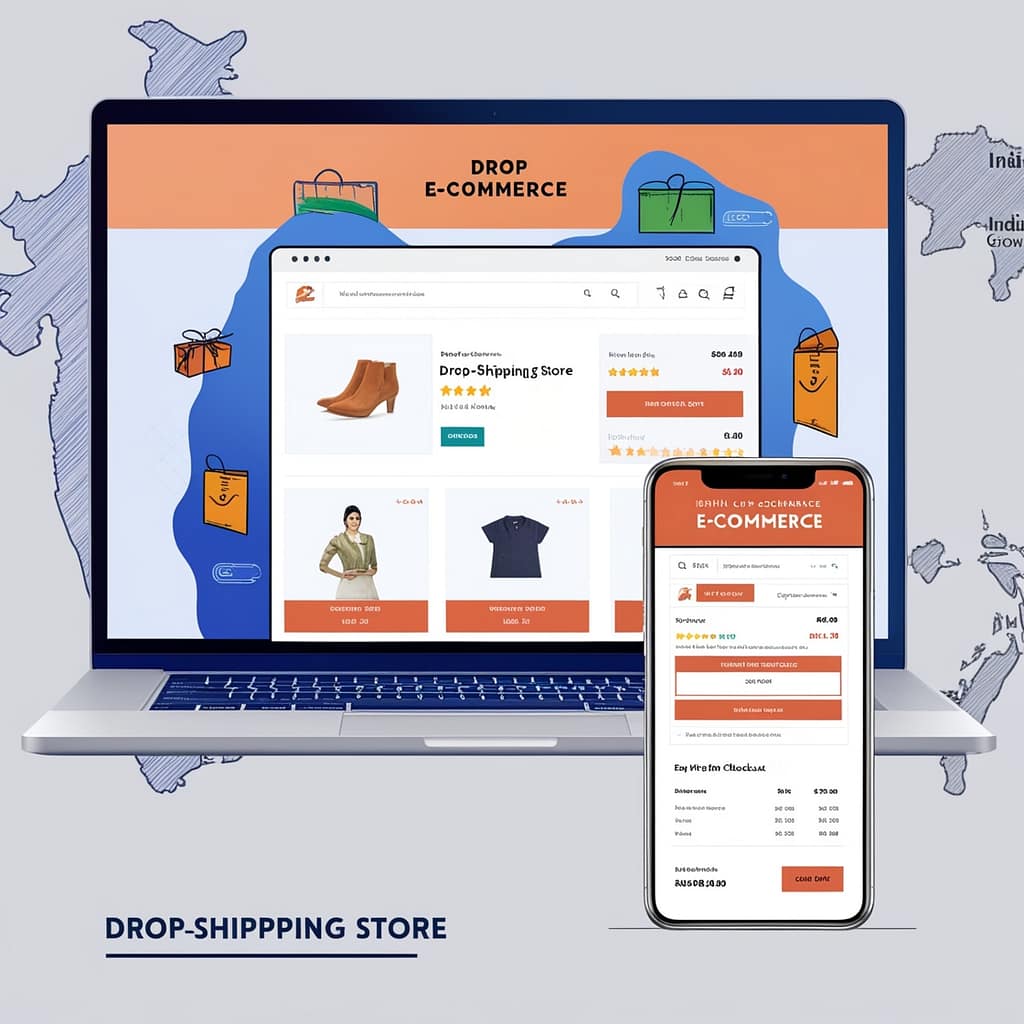Introduction
Drop-shipping has emerged as one of the most promising business models in the digital era. It allows entrepreneurs to operate an e-commerce store without worrying about inventory, warehousing, or shipping. This makes it a low-risk, cost-effective venture for anyone looking to step into the world of e-commerce, especially in a rapidly growing market like India.
If you are wondering how to start a drop-shipping business in India, you’ve come to the right place. In this article, we will walk you through every aspect of setting up a successful drop-shipping business, from choosing the right niche to finding reliable suppliers, and optimizing your online store for growth.

What is Drop-shipping?
Drop-shipping is a retail model where you sell products without managing stock or handling physical inventory. You collaborate with a supplier who manages the storage and shipping of products directly to your customers on your behalf. Your responsibility as the store owner is to focus on marketing and managing customer relations. In essence, you act as a middleman between the customer and the supplier.
Why Choose Drop-shipping in India?
India’s booming e-commerce sector, the growing penetration of internet users, and the availability of cost-effective products make it an ideal environment for drop-shipping businesses. The relatively low startup cost and the ability to operate with minimal overhead are some of the key advantages. Besides, India’s growing middle class has an increasing appetite for online shopping, offering a ready customer base.
Step-by-Step Guide to Starting a Drop-shipping Business in India

1. Choose a Profitable Niche
A niche refers to a targeted section of the market that your business will cater too specifically. Identifying a profitable niche is crucial for the success of your drop-shipping business. Look for trending products that have steady demand but aren’t too competitive. Some popular niches in India include:
- Health and wellness products
- Fashion accessories
- Tech gadgets
- Home decor
- Eco-friendly products
To determine the profitability of a niche, use tools like Google Trends and keyword research tools to understand the demand and competition level.
2. Research and Find Reliable Suppliers
The backbone of any successful drop-shipping business is the supplier. You’ll need to partner with reliable suppliers who can deliver quality products on time. A poor supplier can lead to late deliveries and bad customer experiences, which can damage your brand reputation.
Some platforms where you can find Indian and international suppliers include:
- AliExpress
- India-MART
- Trade India
- Oberlo
When choosing a supplier, check their reviews, delivery times, and product quality. Always test the products yourself before offering them to your customers.
3. Set Up Your Online Store
Your e-commerce website is the face of your drop-shipping business. To get started, you can use platforms like Shopify, WooCommerce, or Magento, which are easy to use and offer customization options. Your store needs to be visually appealing, user-friendly, and mobile-optimized to ensure a seamless shopping experience.
Key elements to include in your store:
- A professional-looking homepage
- High-quality product images
- Clear product descriptions with SEO-friendly keywords
- Customer reviews and ratings
- A simple and secure checkout process
- Optimize Your Store for SEO
Search Engine Optimization (SEO) plays a vital role in driving traffic to your online store. By optimizing your website with the right keywords, meta descriptions, and headings, you can improve your ranking on Google and attract organic traffic.
Some important SEO strategies include:
- Keyword Research: Use tools like SEMrush or Ahrefs to identify relevant keywords with high search volume but low competition.
- On-page SEO: Optimize your product pages with the right keywords, engaging meta descriptions, and high-quality images.
- Technical SEO: Ensure that your website loads quickly, has an SSL certificate for security, and is mobile-friendly.
- Backlinks: Build backlinks from reputable websites to improve your store’s domain authority.
5. Promote Your Store
Once your store is set up, you need to promote it to reach potential customers. Here are some effective ways to market your drop-shipping store:
- Social Media Marketing: Leverage platforms such as Instagram, Facebook, and Pinterest to display your products and connect with potential customers. Google Ads: Run targeted ads to drive traffic to your store. You can use Google Shopping ads to showcase your products directly in search results.
- Influencer Marketing: Partner with influencers who can promote your products to their followers.
- Content Marketing: Start a blog on your website that covers topics relevant to your niche. This helps in building your brand’s authority and improving your SEO rankings.
6. Manage Orders and Customer Service
Efficient order management and excellent customer service are essential for the long-term success of your drop-shipping business. Once a customer places an order, you need to notify the supplier to fulfill it.
Make sure you:
- Keep track of your orders to avoid delays.
- Keep customers informed through email alerts that automatically update them about the progress of their orders.
- Provide a robust return and refund policy to build trust.
7. Scale Your Business
Once your drop-shipping store starts gaining traction, it’s time to think about scaling. Here are a few strategies to grow your business:
- Expand your product range: Add more products within your niche or explore new niches.
- Leverage email marketing: Build a mailing list and send targeted emails with promotions, discounts, and new arrivals.
- Outsource tasks: As your business grows, you can outsource tasks like customer service and marketing to save time and focus on strategy.
- Automate processes: Use tools that can automate inventory management, order processing, and customer support.
Challenges of Drop-shipping in India
While drop-shipping has many benefits, there are also challenges, especially in India. Some common challenges include:
- Shipping times: International suppliers can take weeks to deliver products, which might frustrate customers.
- Customs and duties: Importing products can attract customs duties, which can increase the cost for the customer.
- Product quality: Since you don’t control the production process, the quality of the products can sometimes be inconsistent.
By carefully selecting your suppliers and managing customer expectations, you can overcome these challenges.
Conclusion
Starting a drop-shipping business in India can be a lucrative venture if done correctly. By choosing a profitable niche, partnering with reliable suppliers, optimizing your store for SEO, and promoting it through various channels, you can build a successful e-commerce business without the hassle of managing inventory. The key is to stay consistent, adapt to the market, and always prioritize your customers’ needs.
If you Want to Learn How to Make Money Online Then Click here Full Guide Available

